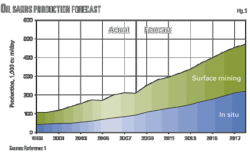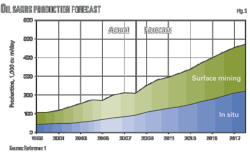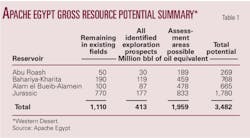Apache Corp., whose Egyptian subsidiary has doubled its Egypt Western Desert output since 2005, sees much more potential in the area.
The company has budgeted 2010 drilling at 220 wells, and chances are fair that number will increase, said Tom Voytovich, vice-president of Apache's Egypt Region. The figure includes more than 50 exploratory wells.
Apache drilled 164 wells in Egypt in 2009 when capital was constrained due to the economic downturn.
Apache's Egypt production, which comes from formations at 3,000 to below 15,000 ft, is expected to remain close to its present mix of 60%-40% in favor of oil and condensate.
An exploration date, in mid-2011, looms on only one of Apache's Egypt concessions, and the company is already working on an extension request.
The company always desires to add acreage, little is available, and what is has less favorable terms than Apache's current holdings that date to the 1980s-90s. Apache is encouraging the government to hold a Western Desert bid round, which hasn't happened in 5 years.
Setting the goal of doubling production resulted from an effort to align the interests of the company and the government, with Apache supplying the resources and commitment and the government agreeing to fast-track decisions and approve importation of the needed resources, Voytovich said.
Production growth
Apache is producing 195,000 b/d of oil and condensate and 810 MMcfd of gas and has 25 rigs under contract.
The oil figure is 27% of Egypt's daily oil output. The combined output makes Apache the country's third largest producer behind BG PLC and the International Egyptian Oil Co. joint venture of Eni SPA and Egyptian General Petroleum Corp.
Apache has invested $4.2 billion in exploration, development, and facilities to double its output, generating an average of $10.6 million/day of revenue to the Egyptian government in this year's first quarter. JVs with EGPC employ nearly 4,500 Egyptians.
The company has 22 total concessions and 63 development leases covering 11 million acres, or nearly one fourth of industry-held land in the Western Desert.
The 1,650 wells on those blocks work out to a density of 1 well per 9 sq miles, leaving the area underexplored, Voytovich said.
During the 5 years, Apache drilled 869 new wells, discovered 57 new fields, implemented 13 waterflood projects, and shot 3.8 million acres of 3D seismic.
The concessions produce from 205 reservoir zones in 118 fields. The Jurassic Safa formation holds most of the reserves found since 2000, but the company has identified large remaining potential in Cretaceous and Jurassic zones (Fig. 1 and Table 1).
One recent completion that helped the company reach the production-doubling goal 7 months early is the Phiops-9 well, which tested at 4,632 b/d of oil from the Cretaceous Alam el Bueib-3E formation in the Faghur basin. Apache expects to be producing 40,000 b/d from the basin by the end of 2010.
The company's acreage covers all or parts of the Faghur, Shushan, Matruh, Alamein, Abu Gharadig, Ghindi, and Beni Suef basins.
Technology contributions
Apache has introduced technology to Egypt in waterflooding and polycrystalline diamond compact bits and may soon add horizontal drilling, Voytovich said.
It is also places heavy reliance on 3D seismic. Company explorationists are mapping on 2,220 sq km of 3D seismic shot in 2009 to replenish the prospect inventory, and Apache plans to have shot 3,775 sq km of 3D seismic in 2010 in five surveys across 10 concessions.
Apache, which operates a total of 27 waterfloods, has engineering and conceptual studies under way for another 10 floods. The company presumes more such opportunities will become apparent, particularly beyond the focus of the Upper Cretaceous, Voytovich said. He said Apache introduced organized, engineered waterfloods to the country.
The company first landed PDC bits in the Western Desert in mid-2008. A typical well that took 94 days to drill to the Jurassic at 14,500 ft in mid-1994 now reaches total depth in 27 days, for a 58-60% reduction in dry hole cost to $2.2 million/well.
Apache transferred use of the PDC bits to Egypt from its US Central Region, where Voytovich observed their use in Oklahoma and the Permian basin in 2006.
Voytovich said Apache hasn't had much application for horizontal drilling but probably will employ it in the Western Desert within a year.
Deeper drilling is also on the company's radar. The bottom of the presently targeted horizons is the base of Jurassic at 16,000-18,000 ft, but below that lies a quite thick column of Paleozoic sediments that are unexplored, Voytovich said.
More Oil & Gas Journal Current Issue Articles
More Oil & Gas Journal Archives Issue Articles
View Oil and Gas Articles on PennEnergy.com



